What: Here's the writing on the back of the photo:
So we're looking at the:
Telephone and look-out hut at Cape D'Aguilar SS.
(I believe the 'SS' means 'Signal Station'.)
No fancy satellite technology in 1909, their telescope handled all surveillance:
and messages were sent by flashing this lamp:
There are mentions of a Signal Station at Cape D'Aguilar in the annual Harbourmaster's report. Here's a typical entry, from 1893 [1]:
31. Telegraphic and Telephonic communication has also been kept up with the Gap Rock and Cape d'Aguilar during the year. [...]
From Cape d'Aguilar 987 vessels were reported, and in addition 70 messages were sent and 123 received.
But the 1905 report [2] notes that the station had closed, replaced by a new station at Waglan island:
Cape d'Aguilar. The reports from this station were discontinued during the year, being superfluous, and on 11th August, on the removal of the Cape d'Aguilar light, the station was vacated by the department.
When: May, 1918.
Who: We know that by 1918 the harbourmaster no longer maintained a signal station here. I guess from their hats that these two men were with the Royal Navy:
Then had the navy always been here, running their own Signal Station in parallel with the harbourmaster's? Or did the navy take over when the harbourmaster moved out?
Or perhaps they were here because in 1918, Britain was still at war?
In theory, one role of a lookout would be to watch for enemy ships. But the German East Asia Squadron, based in Tsingtao, had all left the area in 1914 [3]. Since Japan and Britain were allies in 1918, there weren't any enemy ships to watch for ...
Which meant plenty of free time for a smoke, and having your photo taken!
Where: We know it was at Cape D'Aguilar, the south-east tip of Hong Kong island. But where exactly? The current map of the area has several small square structures marked, spread out over a large area.
The top of the building was wood, and no-doubt is long gone. But the stone base looks sturdy, so there might still be traces of that left.
Theer's a small clue to its location from the shadows. If you zoom in to the wall on the left, there's a clock just above the man's elbow, showing the time is around 9:40am.
The shadow cast by the raised window shows the building is facing towards the sun. Taking the time into account, that means it faced roughly south-east.
As always, corrections and additional information are very welcome. Please leave a message in the comments below.
Regards, David
References:
- Harbourmaster's Annual Report for 1893
- Harbourmaster's Annual Report for 1905, Appendix E.
- German East Asia Squadron
Reference: EA024
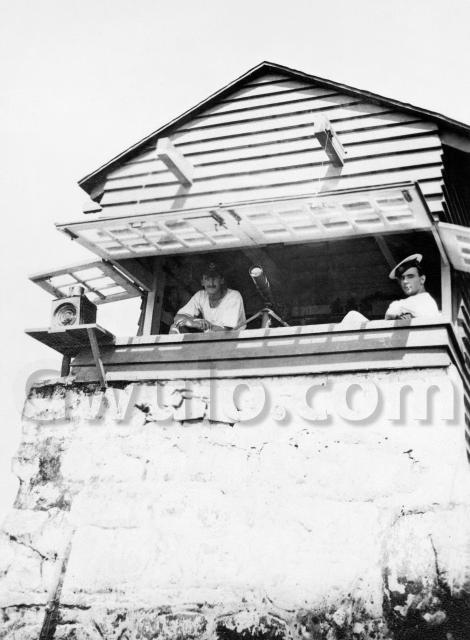
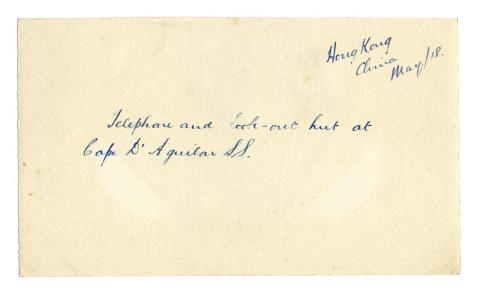
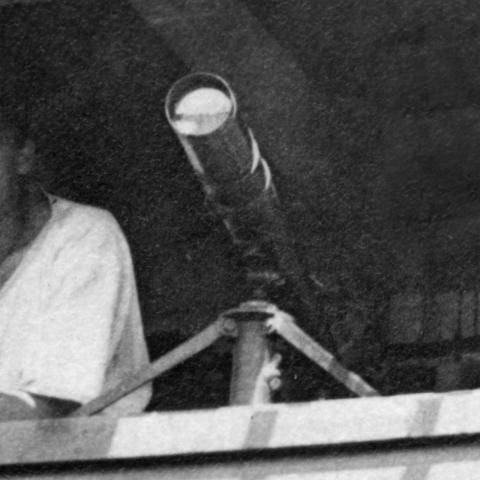
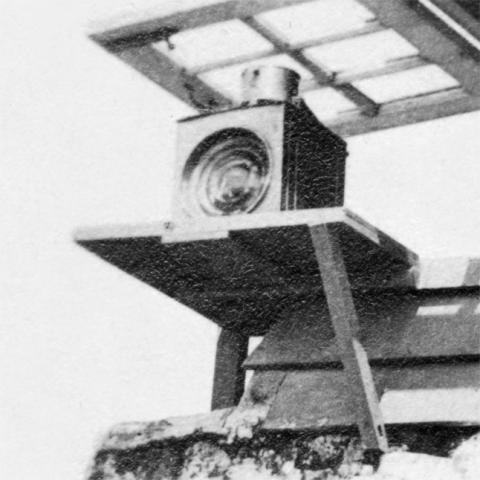
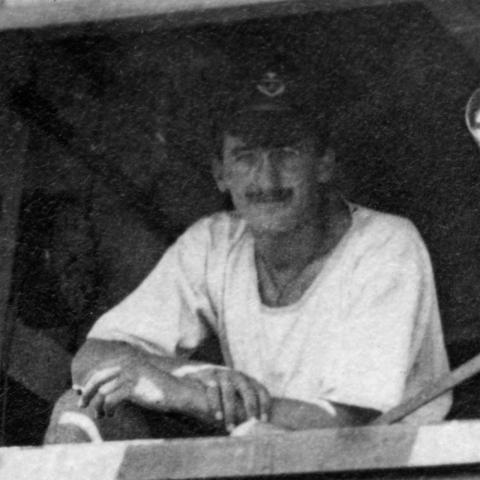
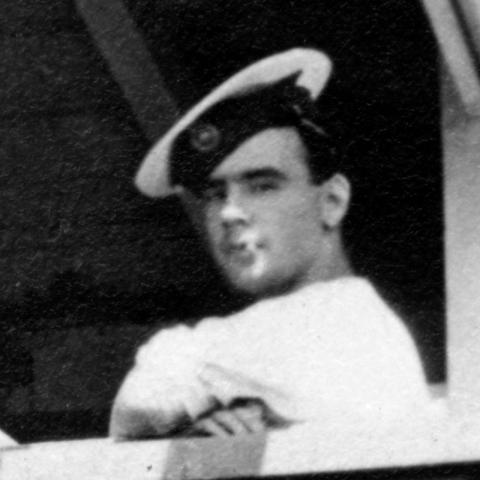
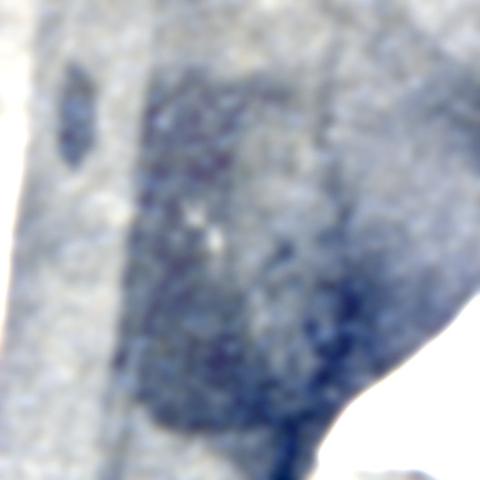
Comments
Cape D'Aguilar Radio Telegraph Station
HKGRO Search for Cape D'Aguilar and 1918 Hong Kong Observatory and Post Office Annual Reports.
On 15 July 1915, the Post Office opened the Radio Telegraph Station at Cape D'Aguilar to transmit and receive radio telegrams and semaphore telegrams to and from passing vessels.
It would appear that the two men in the photo may have been Post Office (Naval Section) personnel. The Annual Reports notes that a Dent chronometer was used for time-keeping.
Not the Royal Navy
Thanks to Ho Lim-peng for his comments:
A facinating shot of an installation I never knew existed. They are not RN personnel-the cap badges are not RN, and RN sailors are not allowed moustaches. The are most likely Harbour Master Office staff, probably ex military or naval.
Britain used to run many coastal signal stations, Lloyd's operated them on UK mainland, some of them still exist in other uses. They were not just there for security, they facilitated the timely provision of harbour services, and collection of harbour dues, and to notify shipping agencies of the pending arrival of their vessels.
So these two men weren't serving with the Royal Navy, but probably weren't part of the Harbour Master's office either, as their reports say they moved out of Cape d'Aguilar in 1905.
Moddsey has opened up a new possibility. I didn't realise there was a Naval Section to the Post Office. Is anyone aware of any other photos of men from this section, to compare their uniforms?
Regards, David
Marine & ?
I asked Stephen Davies at the Maritime Museum, and he identifies the man on the right as a Royal Marine:
The first point to note is that the person on the right is wearing the OLD Royal Marine headgear (with Corps cap badge - something as an ex-RM I instantly recognize!). That is, a Broderick cap, which was uniform for both RMLI and RMA from 1902/03 until c.1922.
There's a very similar cap in the photo 'Royal Marine Light Infantry, England, circa 1918.', near the bottom of this page.
No immediate id on the man to the left though:
The other bloke's cap badge is distinctive, but quite hard to sort out given the resolution. He's either an officer or a senior non-com, given he's wearing a peaked cap. The badge has something of the [look] of an RAF officer's cap badge (in service from 1918 onwards)...but there's something no quite kosher and I'm not sure what it is. The badge isn't the Royal Observer Corps, which had an almost complete wreath (as with RM). For the same reason it isn't RFC.
Here's a WW2 RAF officer's cap badge: http://www.britairforce.com/images/raf_offsolid.jpg - what’s missing in the Gwulo pic is any suggestion of the double line of feathers.
The badge might be some army unit. Given the squillions there were and the common motto scroll across the bottom, a full trawl of army unit cap badges might strike gold…or drive you dotty.
The officer is army, Royal Marines or RAF because RN personnel had to have the full set or no face fungus at all, and this chap's got a moustache. He’s also wearing spectacles, which would suggest that he was not frontline personnel.
Thanks to Stephen for his help.
If you have any suggestions about the man on the left, please let us know,
Regards, David
1918 Lookout at Cape D'Aguilar
Having read Stephen's comments, I wonder if what we are actually seeing here is a military installation, dedicated to maintainig clear range, and registering fall of shot from the coastal gun batteries
re: 1918 Lookout at Cape D'Aguilar
Lim-peng, I agree it seems to be a military site, but I'm not sure if it was related to the coastal batteries or not, as the Bokhara (Cape D'Aguilar) / Chung Hom Kok / Stanley batteries on the south of the island weren't built until the 1930s.
Stephen has been in touch again with further confirmation that the man on the right was a member of the Royal Marine Light Infantry (RMLI):
My Royal Marines’ Museum contact has gone one further with the cap badge and says that it is RMLI (the Corps was divided into the Light Infantry and the Artillery (Lobsters and Bullocks) until 1923).
Given the bootneck [naval slang for a marine], there was obviously an RN element to the coastal observation, the RM detachment in HK being divided between the marines attached to the fleet as embarked units – roughly 500 strong making up 4 or so companies when brought together – and the small shore unit which was primarily responsible for the RN range on Stonecutters Island.
I don’t have the time, but my research programme to sort out the mystery cap badge would eliminate by identifying all British and Indian Army military units with personnel in HK in 1918, finding their cap badges (there is a couple of books the specifically list these, not sure whether any copies are in HK), and just eliminating impossibilities. I haven’t a clue what the insignia history of the Volunteers is, but their unit history has the entry:
“1917 - Hong Kong Defence Corps
The volunteers were actively engaged in guard and patrol duties during World War I when, owing to the recall of the British forces, they were the only military unit left in Hong Kong.”
The Wikipedia entry mentions there was an earlier badge ‘with no Oriental features’…could this be it?
Interestingly as of 1900 a fair few booties transferred to the RHKP – something that has kept going to the present day! In the post-WW1 period in 1921, when briefly the RMLI was given the task of taking over RN Dockyard policing, there was an uptake of RM personnel into the RNDP. Not sure how long that lasted.
I realised that Patricia Lim's project documenting the Hong Kong cemetery gives us an idea of which military units were in Hong Kong at any time. The nature of their work, combined with the high mortality from disease, meant some members of each unit would die during their stay in Hong Kong. Here are the entries I found:
Here's a view of the old-style Volunteers badge. I'm assuming the Hong Kong Volunteer Corps used the same badge as the Hong Kong Volunteer Reserve?
So, no matches from the Army badges. But thinking about it some more, would a soldier from the army be used for a coastal watch, sharing duty with a marine? The badge looks more like an anchor to me, suggesting something connected to the Navy.
I've posted a message to the British & Commonwealth Military Badge Forum, in the hope that one of their experts will recognise it. (When I last checked it hadn't been approved yet. I'll give a link to the message once it is shown.)
Regards, David
Possible match...
Is this photo a match to the man on the left?
Or have I just been eating too many turnips?
Regards, David
ah yes, maybe - but can he do
ah yes, maybe - but can he do slug balancing?
The man on the left
Putting slugs & turnips aside for a moment, the very helpful members of the British & Commonwealth Military Badge Forum have identified the man on the left is wearing a Middlesex Regiment cap badge (see photo of badge). Here's the message from forum member 'Postwarden':
Looks like the cap badge of the Middlesex Regiment to me. Their 25th (Garrison) Battalion arrived in Hong Kong in April 1917 and stayed ther until August 1918 when it went to Siberia (source: Brig James; British Regiments 1914-1918.
And my reply:
Thanks very much for the quick reply.
Funnily enough I'd recently written about the Middlesex Regiment's arrival in Hong Kong in 1917, as we have a photo of them from that time with a cap 'badge' I'm pretty sure hasn't been seen here before: http://gwulo.com/node/9084
But I couldn't see the badge's wreath in the 1918 photo (and had also got too attached to the idea the 1918 photo showed an anchor), so decided it couldn't be a Middlesex badge. After reading your comments and looking again, I see that the 1918 photo just shows the silver parts of the badge clearly, and the bronze parts are lost in the gloom.
Thanks for setting me straight,
David
So that settles who they were. Now what were they doing?
Regards, David
The lookouts
Thanks to Stephen for some more ideas on how to identify what they were up to:
One answer to the conundrum of finding out what the chaps in the photo were about, if it has to do with shipping control, may be to consult either or both of two maritime sources. One is the chart of the SE Approaches to HK – at some point it will have had no lookout charted, once one was there (since it would have been a daymark (conspic)), it will have been charted. Chart 1180, Approaches to HK, had new editions in Aug 1901, Dec 1904, Nov 1906, Mar 1910, Nov 1912, Dec 1915 and Oct 1925; Chart 3605, Hong Kong to Mirs Bay had new editions in Feb 1908 and Dec 1915; and Chart 3279, Hong Kong Waters East in 1903. Each of these will have been regularly corrected between editions and the construction of the lookout will have been one of them. On the base of a chart below the neat line in the bottom left corner, corrections are entered by number and by year, referenced to the specific notice advertising that particular piece of information (e.g. 5-1915 would mean Notice No.5 of 1915). The ‘notice’ referred to that told people to update their charts with a correction was Notices to Mariners, which was published several times a year (and in HK often prefaced by a notice from the Harbourmaster).
All of the above info could probably be sourced fairly quickly from the UKHO Archive in Taunton.
I remember having seen 'Notice to Mariners' in the HKGRO website. I searched for all 'Notice to mariners' and looked through the results for 1904-1918. No joy, but their search isn't always 100% accurate, so I might have missed the relevant notice.
The UKHO say they're moving their archives to The National Archive at Kew (click 'The Archive' tab on this page), so next time I go there I'll see if I can find anything relevant.
Regards, David
D'Aguilar SS
The Signal Station at Cape D'Aguilar was manned by RN signalmen and RMLI ratings from HMS Tamar. Tamar's WW1 log can be viewed at naval-history.net, See for example 11th August 1916,
4.15am: Discharged two Marines to D'Aguilar SS.
7.55am: Received two ratings from D'Aguilar SS.
9.0am: Discharged two Marines to Jubilee SS and one to Peak SS.